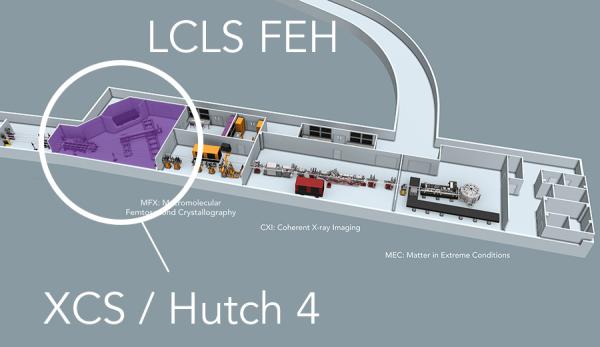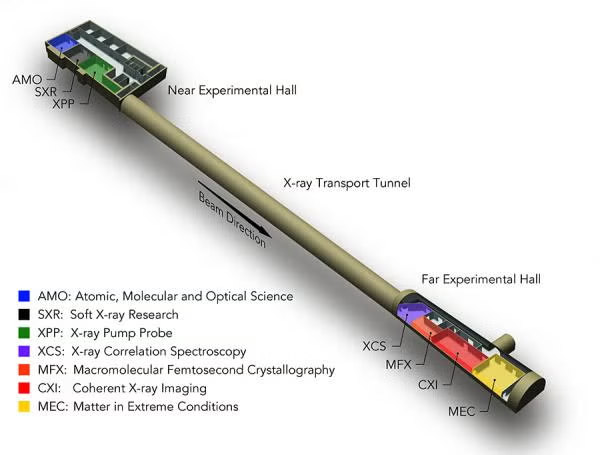XCS Operation Modes
The unprecedented brilliance and narrow pulse duration of the Linac Coherence Light Source provides a unique opportunity to observe dynamical changes of large groups of atoms in condensed matter systems over a wide range of time scales using Coherent X-ray Scattering (CXS) in general and X-ray Photon Correlation Spectroscopy (XPCS) in particular. The X-ray Correlation Spectroscopy (XCS) instrument at the LCLS allows the study of equilibrium- and non-equilibrium dynamics in disordered or modulated materials.
Sequential Mode (Timescales from 10-2 to 103 Seconds)
The shortest time scale of this mode of operation is limited by the LCLS repetition rate (i.e. up to 120 Hz). Important dynamical phenomena at mesoscopic lengthscales can occur on relatively long time scales, e.g. longer than 10-1 s .
This operation mode of operation is illustrated in the frequency-wavector graph. It employs the very large time-averaged coherent X-ray flux from the LCLS, averaged over 120 Hz repetition rate, to investigate dynamics by means of 2D-XPCS data collection.
These experiments consist of collecting time-resolved sequences of speckle patterns on an area detector as shown in Figure 1 [1]. From an analysis of these sequences, correlation times from a few inter-pulse periods up to many minutes can be obtained. The data analysis techniques are similar to those used until now at 3rd generation sources.
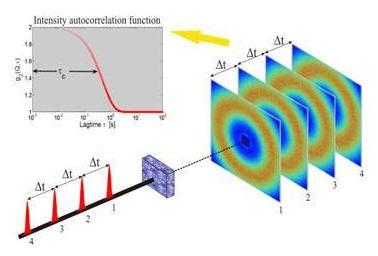
The XCS instrument at LCLS will provide higher signal rates than currently available, thus allowing to probe dynamics at much larger wavevectors than currently possible. It will also offer the possibility to investigate weakly scattering samples.

Split-Delay Mode (Timescales from 10-12 to 10-8 Seconds)
*The split and delay capability is still under commissioning for the XCS instrument.
The short pulse duration of the LCLS hard X-ray radiation (< 250 fs ) allows the extension of XPCS studies to much faster time scales than currently possible.
In order to probe time scales between 10-12 and 10-8 s (as presented in the frequency-wavevector phase space diagram), a split-delay technique shown schematically in Figure 3 is employed and takes advantage of the unprecedented peak brilliance of the LCLS beam.
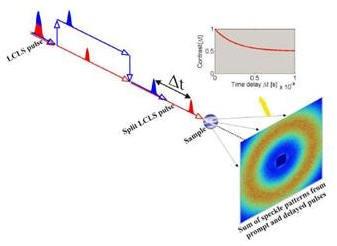
Its concept is to split each LCLS X-ray pulse into two equal-intensity pulses separated in time, but propagating along the same path. The scattering from the two pulses will then be collected during the same exposure of an area detector. If the sample is static (i.e. does not present any dynamics on the time scale of the time delay between the two pulses), the contrast in the summed speckle pattern will be identical to the one of a single pulse. If on the other hand the sample evolves on this time scale, then the summed speckle pattern will present a lower contrast.
By performing the contrast analysis of sets of “single shot” summed speckle pattern as a function of time delay, the correlation time of the system can be measured on time scales down to the pulse duration. Such contrast function (i.e. contrast as a function of time delay) can also be linked to the intermediate scattering function (i.e. the normalized dynamic structure factor in the time domain f(Q,t)), as usually performed in the sequential mode with the second order intensity autocorrelation function [3].
A split and delay unit with a path length difference variable from 3 x 10-6 to 3 m provides delay times from about 10-14 to 10-8 seconds [2].
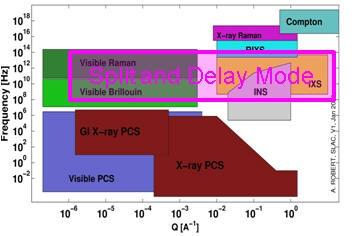
References
- G. B. Stephenson, G. Grübel and A. Robert, X-ray spectroscopy: Revealing the atomic dance, Nature Materials 8, 2010,703
- W. Roseker, H. Franz, H. Schulte-Schrepping, A. Ehnes, O. Leupold, F. Zontone, A. Robert and G. Grübel, Performance of a picosecond x-ray delay line unit at 8.39 keV, Optics Letters 34 (12), (2009), pp. 1768-1770.
- C. Gutt, L. –M. Stadler, A. Duri, T. Autenrieth, O. Leupold, Y. Chushkin and G. Grübel , Measuring temporal speckle correlations at ultrafast x-ray sources, Optics Express 17 (1), (2009), pp. 55-61
XCS CONTACTs
Matthieu Chollet
XCS Instrument Lead
(650) 926-2458
mchollet@slac.stanford.edu
Cynthia Melendrez
Area Manager
(650) 926 2377
cymel123@slac.stanford.edu
Roberto Alonso-Mori
Lead Scientist
(650) 926-4179
robertoa@slac.stanford.edu
Diling Zhu
Senior Scientist
(650) 926-2913
dlzhu@slac.stanford.edu
Tim van Driel
Staff Scientist
(650) 926 3241
timbvd@slac.stanford.edu
Takahiro Sato
Staff Scientist
(650) 926-3749
takahiro@slac.stanford.edu
Sanghoon Song
Staff Scientist
(650) 926-2255
sanghoon@slac.stanford.edu
Gourab Chatterjee
Laser Scientist
(650) 926-5559
gourab@slac.stanford.edu
XCS Control Room
(650) 926-1704
XCS Hutch
(650) 926-7980
